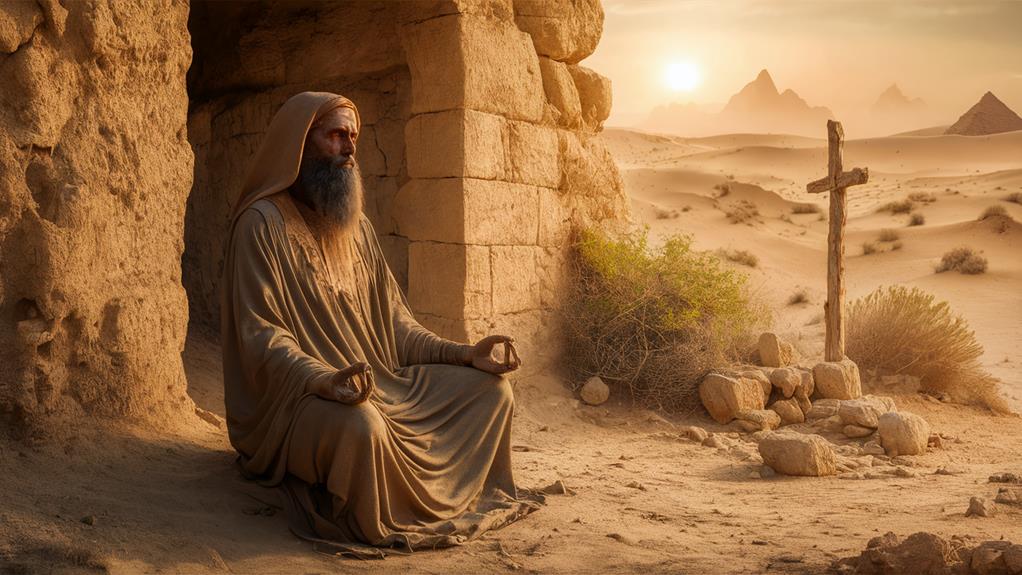What Is Mysticism in the Bible?
You’ve probably wondered about those profound moments in Scripture when humans encounter the divine in extraordinary ways. From Moses’s burning bush to Paul’s blinding light on the Damascus road, the Bible is filled with mystical experiences that transcend ordinary religious practice. These aren’t just ancient stories—they’re patterns of how God initiates intimate relationships with people, often through unexpected and transformative encounters. Whether it’s through visions, dreams, or supernatural manifestations, biblical mysticism reveals a God who isn’t confined to formal worship but actively seeks personal connection with individuals. Let’s explore how these sacred encounters continue to shape faith today.
Defining Biblical Mysticism

Biblical mysticism encompasses direct, experiential knowledge of God through personal spiritual encounters and revelations that transcend ordinary religious practices.
It’s a profound journey where you’ll discover the divine not just through scripture reading or ritual observance, but through transformative moments of connection with the sacred.
When you explore biblical mysticism, you’ll find it’s markedly different from Eastern mystical traditions, though they may share some common elements.
You’re invited to engage with God in ways that go beyond intellectual understanding – through visions, dreams, prophetic experiences, and what the apostle Paul called “deep things of God.”
This mystical dimension doesn’t contradict scriptural authority but rather complements it, offering you a fuller, more intimate experience of faith.
Within this framework, you’ll encounter various forms of mystical experiences described throughout the Bible: Moses’ burning bush, Isaiah’s temple vision, Paul’s Damascus road encounter, and John’s apocalyptic revelations.
These aren’t mere historical accounts but paradigms that illuminate the possibility of direct divine encounters in your own spiritual journey.
Key Mystical Experiences
Throughout the scriptures, mystical experiences manifest in diverse yet distinctive patterns, from profound visions to divine encounters that transformed ordinary individuals into spiritual leaders. You’ll find these moments marked by intense awareness of God’s presence, often accompanied by physical manifestations like bright light, thunder, or overwhelming peace.
Consider Moses’ encounter at the burning bush, where you’d witness the paradigm of direct divine communication – a moment when the natural and supernatural domains intersected in dramatic fashion. You’ll discover similar patterns in Isaiah’s throne room vision, where he’s transformed by encountering God’s holiness, or in Paul’s Damascus road experience that redefined his entire existence.
These aren’t mere historical accounts but templates for understanding how divine encounters can reshape your spiritual journey.
When you explore these experiences, you’ll notice they often follow a consistent structure: initial fear or awe, divine reassurance, personal transformation, and a resulting mission or calling. The mystical encounters don’t just inform theology; they demonstrate how you might experience God’s presence in ways that transcend ordinary religious practice, leading to profound personal transformation and spiritual awakening.
Moses and Divine Encounters

Various divine encounters shaped Moses’ spiritual journey, but none proved more pivotal than his experience at the burning bush on Mount Horeb. In this transformative moment, you’ll find the essence of biblical mysticism – where the mundane transforms into the sacred, and the infinite touches the finite.
As you contemplate Moses’ removal of his sandals, you’re witnessing an act that transcends mere ritual, becoming a profound symbol of human vulnerability before divine presence.
Moses’ encounters with God didn’t end at the burning bush. You’ll discover deeper mystical elements in his ascent of Mount Sinai, where he entered the thick darkness where God dwelled. Here, amid thunder and lightning, Moses experienced what you might call a divine absorption – forty days and nights in God’s presence, emerging with skin that radiated supernatural light.
These experiences weren’t just historical events; they’re archetypal patterns of mystical encounter that you can relate to in your own spiritual journey. When you study Moses’ progression from shepherd to mystic leader, you’ll recognize how divine encounters don’t just change circumstances – they transform the very essence of who you are.
Prophetic Visions and Dreams
Numerous prophetic visions and dreams weave through Scripture’s narrative, serving as divine channels of communication between God and humanity. You’ll find these mystical encounters throughout both the Old and New Covenants, where individuals receive divine messages through powerful symbolic imagery and vivid dreamscapes.
Whether it’s Daniel’s apocalyptic visions, Joseph’s predictive dreams, or John’s revelations on Patmos, you’re witnessing moments when the veil between heaven and earth grows mysteriously thin.
In these sacred encounters, you’ll discover how God’s messages often transcend ordinary language, speaking instead through potent symbols – wheels of fire, mysterious beasts, or ladders reaching to heaven.
You’ll notice how these visions frequently emerge during pivotal historical moments, guiding God’s people through periods of crisis or transformation.
The prophets don’t just passively receive these visions; they wrestle with their meaning, often requiring divine interpretation to reveal their deeper significance.
These mystical experiences remind you that God’s communication isn’t limited to ordinary consciousness – your dreams and visions might become sacred ground where divine wisdom breaks through into your everyday reality.
Jesus as Mystic Teacher

Beyond his role as savior and messiah, Jesus emerges as a profound mystical teacher in the Gospel accounts. You’ll find him speaking in paradoxes and parables that transcend ordinary consciousness, inviting you into deeper dimensions of spiritual understanding. Through his teachings about the Kingdom of Heaven being “within you,” he guides you toward direct, experiential knowledge of divine reality.
When you examine Jesus’s mystical teachings, you’ll discover his emphasis on transformation through inner awakening rather than mere external observance. He consistently points you toward states of heightened awareness, whether through his metaphorical language about being “born again” or his instructions to become “like little children.”
His mystical approach reveals itself in powerful teachings about unity with the divine, as when he declares “I and the Father are one,” offering you a glimpse into ultimate spiritual possibility.
You’ll notice how he often withdraws to pray in solitude, modeling contemplative practice while teaching through both word and example. His mystical wisdom challenges you to move beyond surface-level religion into profound spiritual experience, where you can directly encounter divine presence.
Paul’s Mystical Transformations
The dramatic conversion of Paul on the Damascus road marks one of Christianity’s most profound mystical encounters. You’ll find in this transformative moment a blinding light that knocked him to the ground, forcing him to confront the divine presence he’d been persecuting.
This encounter didn’t just change Paul’s beliefs – it radically altered his entire being, transforming him from Christianity’s fiercest opponent into its most passionate advocate.
Through Paul’s letters, you’ll discover how this initial mystical experience led to numerous other supernatural encounters. He writes of being “caught up to the third heaven,” where he witnessed things that couldn’t be expressed in human language.
You’ll see how these experiences shaped his understanding of Christ’s indwelling presence, leading him to proclaim “it’s no longer I who live, but Christ who lives in me.”
His mystical journey teaches you that transformation isn’t just about changing your mind – it’s about dying to your old self and embracing a new identity.
Paul’s experiences reveal how direct encounters with the divine can shatter your previous understanding of reality and reconstruct it into something far more expansive and profound.
Desert Fathers and Mothers

Ancient sands of Egypt and Syria became sacred ground for Christianity’s earliest mystics – the Desert Fathers and Mothers who fled urban life in the 3rd and 4th centuries to seek God in solitude.
In their quest for divine union, these desert dwellers developed practices you’ll recognize in contemplative traditions today: centering prayer, meditation on scripture, and the disciplined pursuit of inner stillness.
You’ll find in their writings a profound wisdom born of silence and solitude. They’d spend decades in caves and simple shelters, wrestling with their thoughts and confronting their deepest spiritual struggles.
Through this radical renunciation, they discovered what you might call the geography of the soul – those interior landscapes where divine encounter becomes possible.
Their teachings still resonate: Abba Anthony’s insights on spiritual warfare, Amma Syncletica’s guidance on inner transformation, and John Cassian’s instructions on prayer.
You’ll notice how they emphasized practical spirituality over theoretical knowledge. They’d tell you that true mystical understanding doesn’t come from books or lectures but through direct experience – the daily practice of presence before God in the desert of your own heart.
Signs and Wonders
Miraculous manifestations pepper the biblical narrative, from Moses’ burning bush to Paul’s Damascus road encounter. You’ll find these divine interventions scattered throughout Scripture like precious gems, each one revealing how God breaks into ordinary reality to demonstrate His presence and power.
When you encounter these moments in sacred text, you’re witnessing instances where the supernatural domain intersects with the natural world, creating ripples of divine revelation that continue to echo through time.
These signs and wonders aren’t merely historical curiosities – they’re paradigm-shifting events that can transform your understanding of reality itself. You’ll discover that biblical mysticism often manifests through these extraordinary occurrences: the parting of seas, multiplication of loaves, healing of the sick, and raising of the dead.
Each instance invites you to peer beyond the veil of ordinary existence into the deeper mysteries of God’s interaction with humanity. When you contemplate these moments, you’re drawn into a sacred space where the boundaries between heaven and earth grow thin, and you’re challenged to expand your conception of what’s possible in a universe infused with divine presence.
Modern Biblical Mystical Practices

Contemporary believers continue drawing from biblical mystical traditions, adapting ancient practices for modern spiritual growth.
You’ll find Christians engaging in contemplative prayer, where they’ll sit in silence, opening their hearts to divine presence just as the desert fathers once did. Through lectio divina, you’re invited to read Scripture meditatively, allowing the words to penetrate your spirit as you seek deeper revelation.
Many believers have embraced the practice of spiritual journaling, recording their divine encounters and reflecting on Scripture’s mystical elements.
You might experience charismatic worship, where you’ll encounter manifestations of the Spirit similar to those described in Acts. Some communities practice prophetic ministry, seeking direct divine communication while remaining grounded in biblical truth.
You’re also likely to discover modern interpretations of biblical fasting, where you’ll intentionally deny worldly comforts to heighten spiritual sensitivity.
In prayer rooms across the globe, you’ll find believers pursuing the kind of intimate divine encounters that Moses experienced at the burning bush, adapting these timeless practices to contemporary settings while maintaining their sacred essence.
Personal Divine Connection Today
Each person’s journey toward divine connection reflects the Bible’s timeless invitation to experience God personally.
You’ll find this sacred pathway opens through intentional practices that echo ancient wisdom while remaining vibrantly relevant to your modern life. Through contemplative prayer, meditation on scripture, and moments of sacred silence, you’re creating space for divine encounters that transcend traditional religious boundaries.
You’re not limited to formal settings or prescribed methods in seeking this connection. Your daily experiences – from quiet moments at dawn to encounters with nature’s grandeur – can become channels for divine presence.
The mystical tradition teaches that you’ll discover God’s voice in unexpected places: in the gentle whisper of your heart, through meaningful coincidences, or during times of profound stillness. When you cultivate awareness of these sacred moments, you’re participating in the same transformative experiences described throughout biblical narratives.
You’re carrying forward an ancient legacy of divine-human relationship, yet you’re writing your own unique chapter.
This personal connection isn’t about following someone else’s formula – it’s about discovering your authentic path to experiencing God’s presence in your life.
Conclusion
Biblical mysticism invites you to venture beyond surface-level faith into profound encounters with the divine. As you explore these sacred experiences—from Moses’ burning bush to Paul’s Damascus road—you’ll discover that God’s presence remains accessible today. Whether through contemplative prayer, meditation on scripture, or moments of divine connection, you’re called to embrace the mystical dimension of faith that transforms and deepens your spiritual journey.









